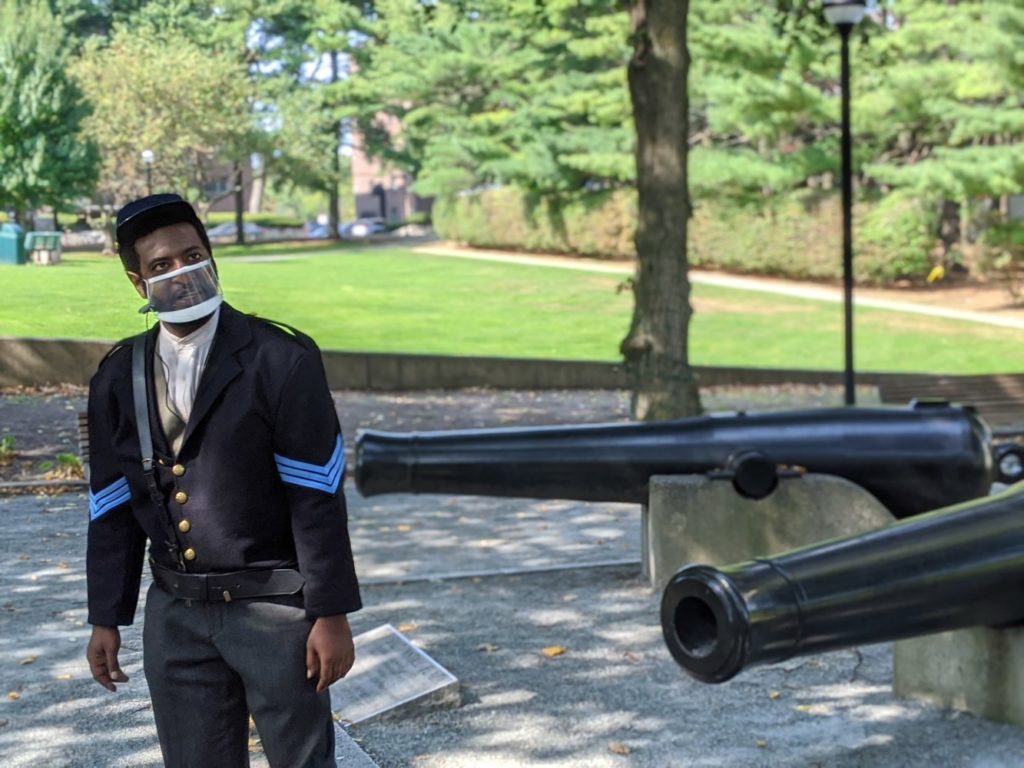
Kadahj Bennett as Charles W. Lenox
Presented by New Repertory Theatre in partnership with the Watertown Free Public Library and the Historical Society of Watertown
The Charles W. Lenox Experience
Script by Ken Green
Directed by Michael Ofori
Performed by Kadahj Bennett
September 26 – November 8, 2020
Audio Description: October 18, 2020 at 1:00pm
ASL Interpretation: October 24 at 1:00pm & October 25 at 4:00
Accessibility information is HERE.
Watertown Square
Watertown, MA
New Rep on Facebook
Critique by Kitty Drexel
Watertown, MA — Trump has COVID-19. He could learn about science from this experience (he won’t). Thoughts and Prayers.
I mention the president because he is a man who remains steadfastly ignorant of his inherent racism. Racism is a social disease that negatively impacts us all; we can’t opt-out. We can only hope to counter it through education and cognitive retraining of the self. It’s as easy and self-monitoring your speech and as complicated as decolonizing our collective world view.
You too can learn from experience! Attend the New Rep’s Watertown Historical Moving Plays: The Charles Lenox Experience and learn all about a nineteenth-century Watertown barber who was one of the first Black men to enlist as a Private in the Civil War. Charles W. Lenox (played skillfully by Kadahj Bennett) leads a small audience across Watertown Square while describing his young adulthood, explaining local politics, and cracking jokes.
The Charles Lenox Experience might draw a comparison to other walking tours such as the Boston Ghost Tour, or the Freedom Trail Tour. While understanding that these companies employ many fine New England actors, New Rep’s production is not either of those. It is its own beastie.
The length and immersive style of this play allow Bennett to concentrate on his character rather than garnering tips. He gets to play, to appeal to his audience inside the fourth wall while the outside world continues outside of it. The audience is a co-conspirator rather than a casual recipient of the performance.
Bennett and director Ofori employed some clever techniques to keep the audience honed in on the story. Charles conveniently finds props in new locations during the play. An old-timey newspaper that looked like a modern poster until it was discovered was stuck to a street sign. Bennett altered his postures and walks to reflect age and maturity. In a long scene between father and son, Bennett – having no sound designer at his disposal – exclaimed “Schhhhhpt!” to indicate the switch into a new character.
W.C. Fields said that actors should, “Never work with children or animals.” Fields didn’t account for the invention and mass distribution of the motorized unicycle. Bennett shouted, in character, “What is that?!” to the amusement of his audience as the unicycle scooted by. From afternoon traffic to a naughty mic pack, Bennet coped with an onslaught of unplanned interruptions with aplomb.
The performance occurs on sidewalks and other public areas in Watertown Square. Sometimes public seating such as benches and grassy areas is available due to the strategic nature of Watertown’s city planners. Most times, attendees must stand on the pavement. One thoughtful attendee brought their own portable chair (lightweight and compact) which she carried like a champ on our short, stop-and-start walk across the square.

Kadahj Bennett as Charles W. Lenox
The Charles Lenox Experience is approximately 60 minutes long; the show will run longer if attendees move at a slow pace. Bennett thoughtfully waits for all patrons to be in a space before beginning a monologue. Those with a schedule to keep should allow at least 75 minutes for this performance.
As much as things change, things resolutely stay the same. Watertown Soldiers’ Monument sits in Saltonstall Park. It depicts in granite a white soldier standing with one hand holding up the barrel of a musket and the other at his hip. His right foot stands a step higher than the left. This 1889 statue to commemorate the Civil War, the war that ended most forms of slavery in the US, remembered the white soldiers first (only?) and made no mention of the slave trade when it was first erected.
The statue was restored in 2013. The committee in charge didn’t think to use the opportunity to commemorate in specific the Black citizens who fought and died for their country in the Civil War. When we say #BlackLivesMatter, we also mean that BIPOC lives should be included with regularity in our history books as more than a brief chapter on slavery. Black dreams, Black contributions, Black history is equally as important as that of the colonizers who inspire the common curricula.
For Black lives to truly matter, the efforts of men like Charles W. Lenox must be remembered on purpose. Lenox and his fellow justice warriors sacrificed greatly for a country that considered him a secondary citizen. He deserves more than just a performance (no matter how delightful) on a sunny fall day for the entertainment of a handful of mostly-white theatre patrons who largely take him for granted. He did in 1870 when the 15th Amendment was ratified and he does now.
